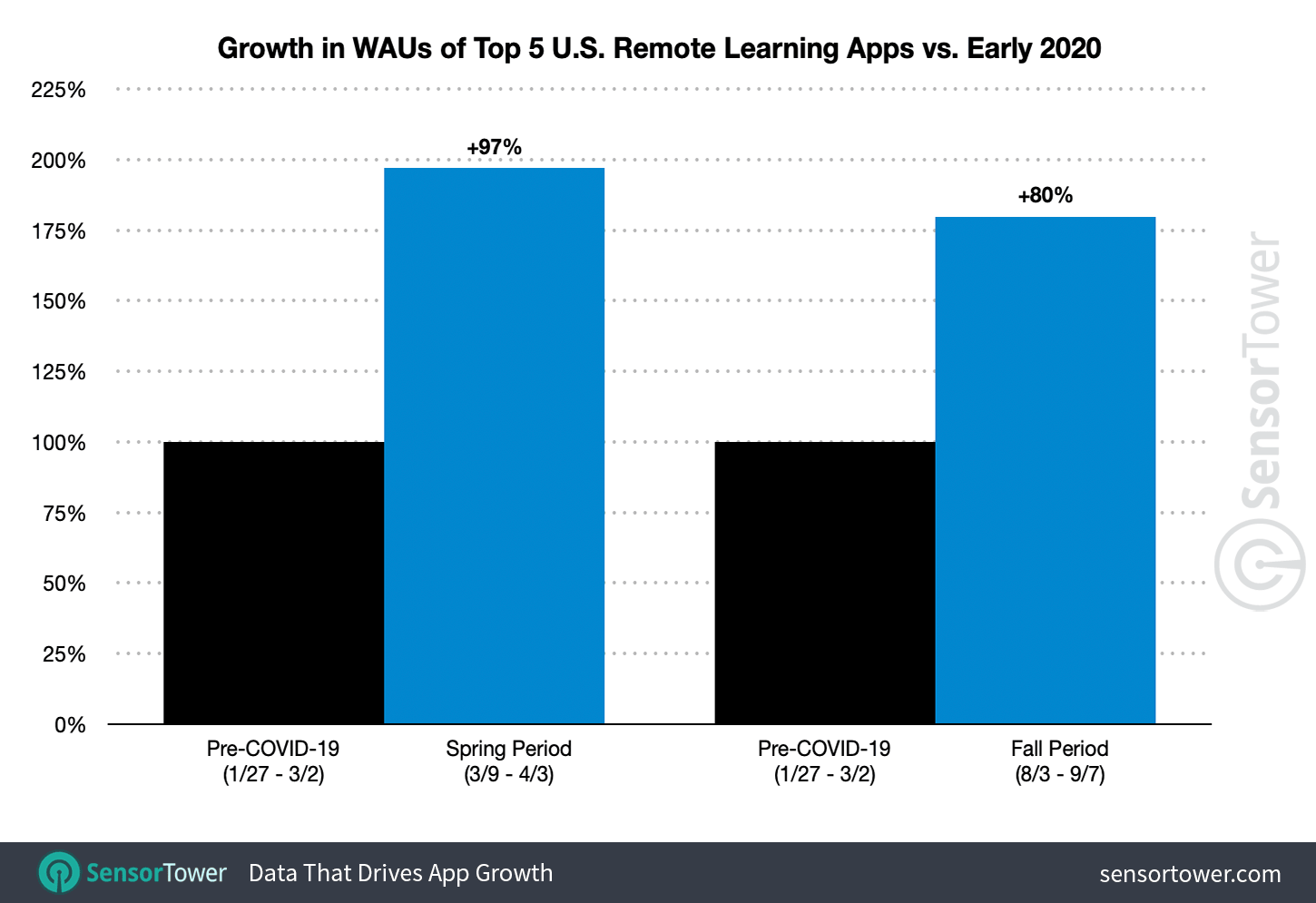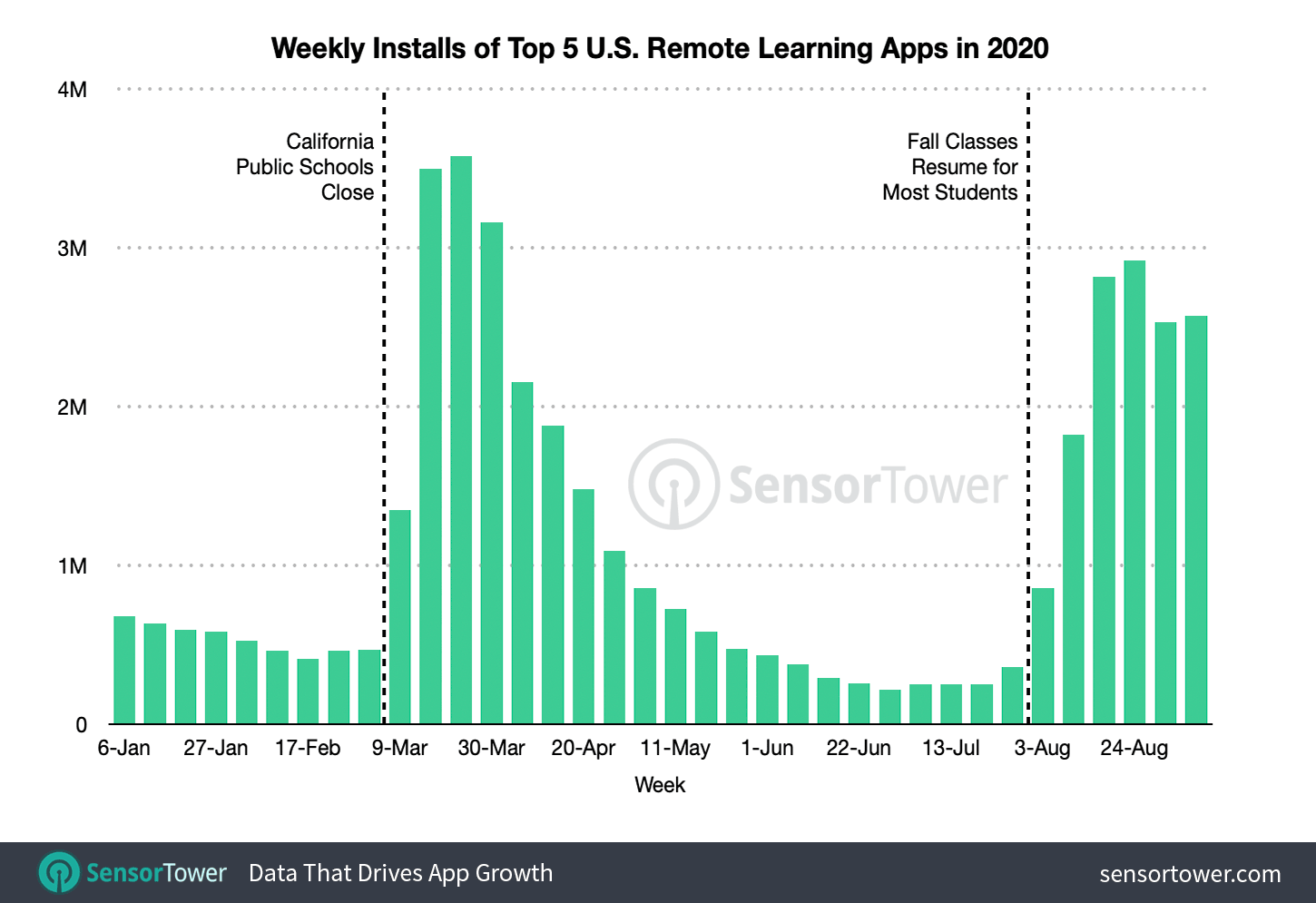
As the spread of COVID-19 forced school closures across the United States in early March, educators quickly adapted to the sudden necessity of virtual classrooms. This led to an unprecedented increase in the adoption of remote learning apps. With the arrival of the fall semester, some students are now finally returning to physical classrooms. According to Sensor Tower Store Intelligence data, however, this has only marginally affected the usage of these apps.
Our analysis reveals that, in the six weeks following the start of school for most U.S. students on August 3, the top five remote learning apps saw their weekly active users (WAU) reach 91 percent of their previous level during the same period after the majority of schools closed on March 9.

The cohort of apps we analyzed include the five most downloaded education apps for remote learning in both semesters: Google Classroom, Remind, ClassDojo, Flipgrid, and Canvas Student. Although their WAUs have collectively declined from the spring period, usage of these apps has been trending upwards as the fall semester gets underway. The cohort’s WAUs in the week of September 7 was 49 percent higher than during the week of August 3. This indicates that remote learning is still a significant aspect of daily life for many of the students who are able to participate, or that institutions who experimented with remote learning in the spring have decided to continue integrating it into their approach to distanced education.
Comparisons to the spring period aside, the data confirms that more classrooms—and students—are using these apps than in years past. The WAUs for this cohort of apps was up 64 percent from the same six weeks in 2019 and 86 percent from this period in 2018.
The Top Virtual Classroom Apps
In addition to our analysis of WAUs for the top five remote learning apps, we also looked at their downloads, which are on pace to match their level of installs earlier this year. In the spring period we studied, the same cohort of apps collectively reached 15.6 million installs; in the six weeks since August 3, the cohort’s installs decreased by 13 percent to 13.5 million.
There are a few possible contributors to the lower install rates, such as schools opting to use different tools or reinstating in-person learning. The main cause of the decline, however, is likely that many students already have those apps on their mobile devices and don’t need to install them as classes resume once more.

Installs of the top five remote learning apps previously peaked during the week of March 23, when they generated 3.6 million installs from across the U.S. App Store and Google Play. The cohort of apps we analyzed also saw a spike in installs when schools began re-opening in late July, climbing 139 percent between the weeks of July 27 and August 3. This surge in uptake of these apps was lower when compared to the initial period of school closures, when the cohort saw its installs increase 188 percent between the weeks of March 2 and March 9.
So far in the fall semester, the cohort’s installs have peaked at close to 3 million installs during the week of August 24. In both periods, Google Classroom saw the most installs, generating 8.2 million in the spring semester and 4 million in the fall. Canvas Student saw the second most installs in the period starting August 3, climbing 220 percent to 3.1 million installs from 969,000 in the March period. The third largest app by downloads was Remind, which reached 2.9 million installs, up 16 percent from 2.5 million in the period starting March 9.
No One Size Fits All
It’s clear that remote-learning apps are still playing a significant role as students return to school this fall. However, consumer behavior continues to evolve as educators and parents explore different tactics to balance in-person and virtual education, such as learning pods where several students in the same bubble gather to share a single screen. And though education apps present a plethora of benefits, they also come with a set of new challenges. Just as schools will inevitably continue to test new technologies in their efforts to recreate the classroom virtually, developers will also have to experiment with use cases to pinpoint how their apps can fit educators’ specific needs and fill gaps not addressed by the current slate of top apps.
Sensor Tower’s Store Intelligence platform is an Enterprise level offering. Interested in learning more?

